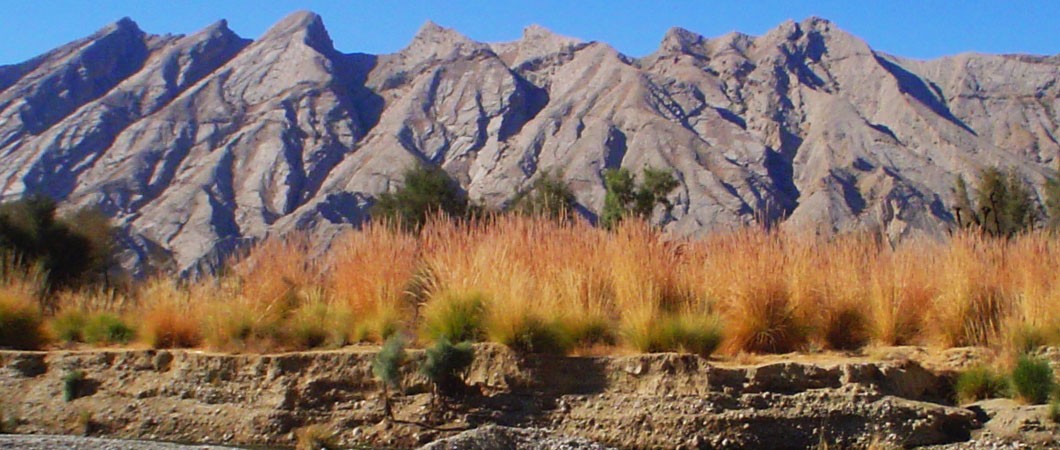
Some random thoughts from a journey from Quetta to Taftan

We cherish the fact that Balochistan is a resource rich province. Not many people are bothered that it is an extremely underdeveloped province. My thoughts here are a consequence of my journey from Quetta to Taftan. A dusty border town in Chaghai district on Pakistan’s border with Iran, Taftan is located at a distance of about 627 kilometres from Quetta, the provincial capital and probably the only place to actually qualify for a city in Balochistan.
For an admirer of William Wordsworth, the sheer wilderness in Balochistan is breathtaking. An open sky from above, unattended dust bowls dotted by bushes -- and where date trees and green orchards make rarest appearance -- and ubiquitous mountainous ranges of high and low altitudes of dark, dark blue and grey colours, heralding the presence of minerals, which Balochistan is well known for -- all a welcome sign for peace of mind. The scenic deserts traversed by domesticated camels in Nokcha area of Dalbandin remind one of Arab desert land.
With a rail track running through the deserts, the sandy hills provide best shots for a movie: a perfect location to shoot desert and mountain scenes in the myriad wilderness from Dalbandin to Noukandi. Going through the sand dunes, one is reminded of Hollywood hits like Lawrence of Arabia and The English Patient --spontaneous, fascinating blasts from the past.
Exhilarating to a nature lover, the mesmerising diversity of Baloch mainland is ironically a painful reminder of a harsh habitat and very little life for its inhabitants. Past Lakpass Tunnel in Mastung district, to the last limit of one’s eyesight, the only sign of life one encounters is vehicular traffic on the national highway. One finds sparsely populated villages around small muddy towns deprived of even basic amenities of life: health facilities, clean drinking water and education.
Extreme weathers, from droughts to heavy downpour, only further the worries of the poor rural dwellers: killing of animals in the first case and inundation of homes in the latter. Ignoring the painful sights of school-age Baloch children, selling edibles along the roadside to provide for family, will be a casual disregard for Article 25-A of our constitution, guaranteeing free and compulsory education to all children aged 5 to 16 years.
The sight of Ras Koh hills in the Chaghai district, where Pakistan set off its nuclear tests in 1998, is the site of pride for us though it has never bothered governments to realise that they had any responsibility to the people of the district.
A major portion of road, from Quetta to Taftan, is in good condition though not the standard of a national highway. High speed is a blithe disregard for the dangers that the road offers. Besides its narrow width, on several places, the highway is unpaved or does not exist at all, causing immense difficulties to passengers. Past a few kilometres from Noukandi up to Taftan, the incredibly dilapidated condition of the road poses a serious danger to the lives of motorists. It is a pity for a national highway to be in such an abysmal condition.
In reality, for the Baloch, the abundance of minerals and their vital strategic importance have meant more sufferings and very little development. In Balochistan, Pashtun populated north-west is comparatively more developed, thanks primarily to the British era development among the less tribal society, being more populous and Pashtun entrepreneurial zeal. Baloch populated south and south-east are more underdeveloped owing mainly to Baloch tribalism during the colonial and post-colonial periods, being sparsely populated and centre’s utter negligence since independence.
The latest episode of Baloch separatism has a strong economic component: a militant struggle against Islamabad’s excessive centralisation and exploitation of Baloch resources without their development. In addition, a far deeper problem is lack of farsighted leadership. Out of power, Baloch and Pashtun nationalists are, probably, the most critical in demanding their due share from centre. In power, their narrow, selfish and personal interests are too important for them to be sacrificed for the sake of public good.
"The people of Balochistan are children of a lesser god," lamented a government official. What should the government do to kick-start Baloch development?
There are three new corrective steps that should be implemented initially in Noushki and Chaghai districts to serve as a model for the rest of districts.
First, aggressive agricultural development on the vast land will not only eke out a living for the poor Baloch, it may have the capacity to make the whole country self-sufficient in food. Facilitated by high intensity sun rays, the use of solar panels to provide electricity to tube wells will render loadshedding meaningless. Solar tube wells to pump water from the depth of up to 1000 feet are already in use in parts of the province. This use of solar energy will also relieve the government from heavy power subsidies. Irrigation will also sustain the livestock industry.
Second, the central and provincial governments should invest in developing at least one small city in each district -- 31 in all -- of the province where all the essential amenities of life are made available. That may act as a magnet for people to opt for urban living.
Third, the government should charge a district development duty, in Noushki and Chaghai districts, on all imports and exports that move between Taftan to Quetta and the other way round. The sum collected should be exclusively used for health and education purposes.
For peace to take root in Balochistan, economic development is inevitable. Coming to terms with a shift away from a typical security state orientation to one informed by welfare of the people is the way to success.